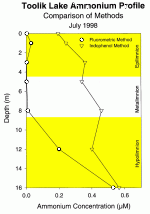In unpolluted environments, ammonium concentrations in lakes and streams are near the detection limit for the standard colorometric method used in hundreds of laboratories. For lack of a better method, we have used this standard method for decades at the Arctic LTER site but results were often variable. While limnologists are good at interpreting just about any patterns, we have been suspicious of this method.
Worse, the results of our tracer studies of the fate of 15N-ammonium indicated that measured stream values were likely several times too high.
Now, using a new fluorometric procedure (Holmes et al. in press), developed and tested in part with LTER funding, we are able to accurately measure even very low ammonium concentrations, at the 0.02 µM level, and reveal interesting patterns wherever we look.
For example, in the ultra-oligotrophic Toolik Lake, we measured the rate of benthic mineralization in the deep water following stratification. Ammonium measurements also allowed us to identify and trace river water as it moved through the epilimnion of the lake.
In the nearby Kuparuk River, we have for the first time been able to observe the expected ammonium decline downstream of the phosphorus addition site.
This new method also works in the wide range of salinities of the Plum Island Ecosystem LTER site; it will lead to important new insights about ecosystem functioning worldwide. These results illustrate how the long-term nature and flexibility of the LTER projects both helped to identify a need and to solve the analytical problem. The feeling of scientific sense replacing non-sense is intensely satisfying.
Holmes, R. M., A. Aminot, R. Kérouel, B. A. Hooker, and B. J. Peterson. in press. A simple and precise method for measuring ammonium in marine and fresh water. Canadian Journal of Fisheries and Aquatic Sciences.

 Enlarge this image
Enlarge this image